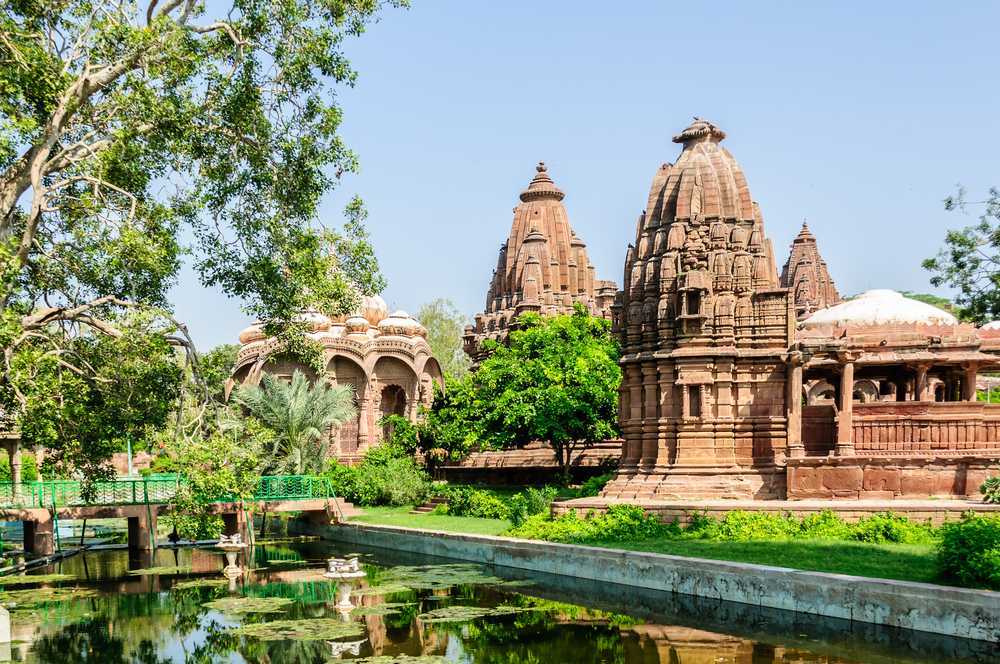Mandore Gardens: A Historical Oasis in Jodhpur
Nestled just 9 kilometers north of the bustling city of Jodhpur in the enchanting state of Rajasthan, India, Mandore Gardens stands as a captivating testament to the region’s rich history and cultural heritage. This verdant oasis of tranquility offers visitors a journey through time, immersing them in the legacy of Marwar, the former capital of the region.
The history of Mandore Gardens stretches back centuries, tracing its roots to the 6th century AD when it served as the abode of Marwar’s rulers. The gardens, with their meticulously designed landscape, became a symbol of grandeur and power. Today, they have become a cherished tourist attraction, drawing visitors from all corners of the globe.
One of the most striking features of Mandore Gardens is the collection of cenotaphs, or chhatris, dedicated to the Marwar rulers. These cenotaphs stand as majestic structures, showcasing a harmonious blend of intricate architecture and exquisite craftsmanship. Each cenotaph is adorned with delicate carvings and sculptures, embodying the artistic prowess of the bygone era. The most notable among them is the “Memorial of Maharaja Jaswant Singh II,” a grand cenotaph that stands as a testament to the ruler’s legacy.
As one wanders through the gardens, the “Hall of Heroes” captures the imagination. This section of the gardens features statues of legendary Rajput warriors, proudly showcasing their valor and indomitable spirit. The statues pay homage to the gallant warriors who defended the land with unwavering courage, leaving an indelible mark on history.
Mandore Gardens, enveloped by nature’s embrace, offer respite from the clamor of city life. The manicured lawns, vibrant flowers, and lush greenery create a serene and tranquil atmosphere, inviting visitors to pause and immerse themselves in the beauty of their surroundings. The gardens also offer panoramic vistas of the surrounding hills and landscapes, adding to their allure.
The gardens are not only a testament to architectural brilliance but also a place of cultural significance. Numerous pavilions and temples dedicated to Hindu deities, such as Lord Shiva and Hanuman, dot the landscape. The “Shrine of the Three Hundred Million Gods” showcases a fascinating collection of deities carved into rocks, evoking a sense of reverence and spirituality.
Mandore Gardens have been recognized for their historical and cultural importance. The Archaeological Survey of India (ASI) has declared them a National Heritage, ensuring their preservation for generations to come. The gardens also house the Government Museum, which showcases artifacts and ancient relics that offer a glimpse into the glorious past of Marwar.
Beyond its historical significance, Mandore Gardens serve as a vibrant venue for cultural events, concerts, and performances. The gardens come alive with the echoes of folk music, dances, and traditional festivities, providing visitors with an opportunity to experience the vibrant heritage of Rajasthan firsthand.
A visit to Mandore Gardens is akin to stepping into a realm where history, art, and nature converge. It is an exploration of the legacy left behind by Marwar’s rulers, a journey through architectural splendor and cultural richness. Whether one seeks solace amidst serene surroundings or yearns to delve into the annals of history, Mandore Gardens stands as an enchanting destination that captivates the heart and mind.
Here are 20 facts about Mandore Gardens in Jodhpur, India:
-
- Mandore Gardens is located around 9 kilometers north of Jodhpur city in Rajasthan, India.
- The gardens are known for their historical and cultural significance and are a popular tourist attraction in Jodhpur.
- The gardens were the former capital of Marwar before the establishment of Jodhpur.
- Mandore Gardens have a rich history dating back to the 6th century AD when it was the residence of the Marwar rulers.
- The gardens are home to several cenotaphs, also known as “chhatris,” which are dedicated to the Marwar rulers.
- The cenotaphs at Mandore Gardens showcase intricate architecture and are adorned with exquisite carvings and sculptures.
- The most prominent cenotaph at Mandore Gardens is the “Memorial of Maharaja Jaswant Singh II,” which is the largest and most intricately designed cenotaph in the complex.
- The gardens also house the “Hall of Heroes,” which displays statues of various legendary Rajput warriors.
- Mandore Gardens feature beautiful landscaped lawns, gardens, and lush greenery, providing a serene and tranquil environment.
- The gardens offer panoramic views of the surrounding hills and landscapes.
- Mandore Gardens are not only a tourist destination but also a popular picnic spot for locals.
- The gardens are known for their unique architectural blend of Hindu and Jain styles.
- The “Shrine of the Three Hundred Million Gods” is another notable attraction within the gardens, featuring a collection of deities carved into the rocks.
- Mandore Gardens also house the Government Museum, which exhibits artifacts, ancient relics, and sculptures dating back to the 6th century.
- The gardens have several pavilions and temples dedicated to various Hindu deities, including those of Lord Shiva and Hanuman.
- Mandore Gardens have witnessed the rule of various dynasties, including the Gurjara-Pratiharas, the Marwar rulers, and the Mughals.
- The gardens provide a glimpse into the rich cultural heritage and architectural splendor of Rajasthan.
- Mandore Gardens have been declared a National Heritage by the Archaeological Survey of India (ASI).
- The gardens are a popular venue for cultural events, concerts, and performances, showcasing the vibrant folk traditions of Rajasthan.
- Mandore Gardens offer visitors an opportunity to explore the historical, cultural, and natural beauty of Jodhpur in a serene and picturesque setting.


